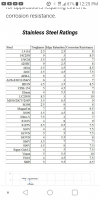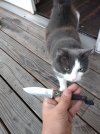In the selection of stainless, I hear that a while ago 13C26/AEB-L (I will only write AEB-L from now) were not desired for general purpose knives because it lacks of edge retention, many saw it as 420 alternative. This was back in the time where 440C and similar in the class were the shiny ones.
Nowadays, many people are looking for high toughness over edge retention, and AEB-L stands out in this property for stainless steel. Its toughness is comparable to many high toughness tool steels. Then it gets newer version like 14C28N and Nitro-V, which are very common in the budget section in to day market as Chinese manufacturers are throwing them out of the production line without a sign of slowing down.
Despite their well known toughness, these steel mostly appear in small fixed blade and pocket knives, which generally doesn't need as much toughness. Currently, there is very few large fixed blade (more than 6 inches) or chopper using these steels, this section of the market is dominated by plain carbon or tool steels like 5160 and 52100. The demand for high toughness is clearly there as I see more and more new people come to knife hobby seem to love indestructible blades. I guess the YouTube destruction tests do the job. Yet, the fixed blades in stainless, not counting powdered steels, are commonly seen in 420HC, 440 series (sometimes under factory designation like N695), 154CM, VG series, AUS-8 and sometimes even D2. Why is that?
On the similar steels that are disregarded, AUS-6 comes to mind. The AUS series has about 13% chromium then the usual, which is the only thing making them similar to 420 series, and the numbers behind denote the average carbon content, for AUS-6, it is ~0.6, very similar to AEB-L. Then like usual, AUS series has the little MoV. People usually says that it is just 420 in a different name or 420 class whatever, especially on Spyderco Forums where the statement is echoed with the 1990s Spyderco knives. As some people are showing their Hattori knives, one of the few place still using this steel, for medium/big knives nonetheless, should we revisit this steel like we do with AEB-L? Testing out it modulus and other aspects?
Nowadays, many people are looking for high toughness over edge retention, and AEB-L stands out in this property for stainless steel. Its toughness is comparable to many high toughness tool steels. Then it gets newer version like 14C28N and Nitro-V, which are very common in the budget section in to day market as Chinese manufacturers are throwing them out of the production line without a sign of slowing down.
Despite their well known toughness, these steel mostly appear in small fixed blade and pocket knives, which generally doesn't need as much toughness. Currently, there is very few large fixed blade (more than 6 inches) or chopper using these steels, this section of the market is dominated by plain carbon or tool steels like 5160 and 52100. The demand for high toughness is clearly there as I see more and more new people come to knife hobby seem to love indestructible blades. I guess the YouTube destruction tests do the job. Yet, the fixed blades in stainless, not counting powdered steels, are commonly seen in 420HC, 440 series (sometimes under factory designation like N695), 154CM, VG series, AUS-8 and sometimes even D2. Why is that?
On the similar steels that are disregarded, AUS-6 comes to mind. The AUS series has about 13% chromium then the usual, which is the only thing making them similar to 420 series, and the numbers behind denote the average carbon content, for AUS-6, it is ~0.6, very similar to AEB-L. Then like usual, AUS series has the little MoV. People usually says that it is just 420 in a different name or 420 class whatever, especially on Spyderco Forums where the statement is echoed with the 1990s Spyderco knives. As some people are showing their Hattori knives, one of the few place still using this steel, for medium/big knives nonetheless, should we revisit this steel like we do with AEB-L? Testing out it modulus and other aspects?







